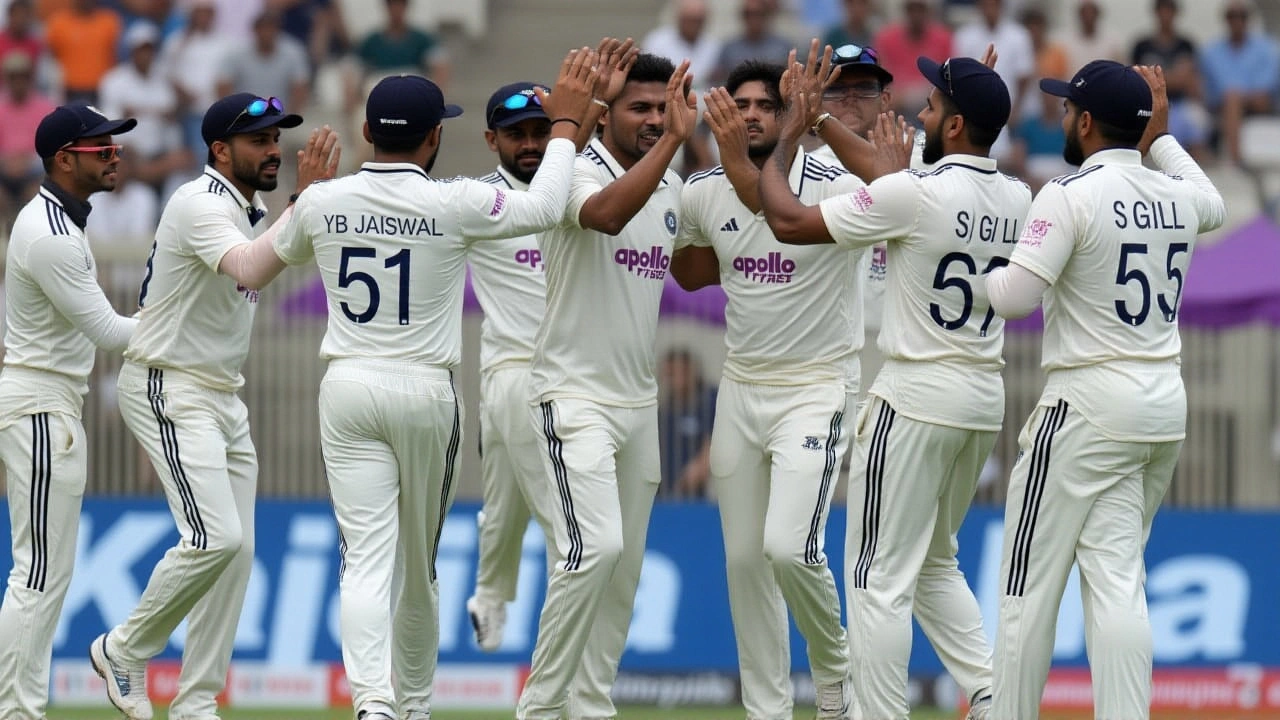When Jasprit Bumrah and Mohammed Siraj ripped through the West Indian top order at the India vs West Indies 1st Test, the crowd at Narendra Modi Stadium in Ahmedabad felt the electricity of a classic Test debut. The West Indies, having won the toss on 2 October 2025, chose to bat and were bundled out for a modest 162. By stumps, India had slipped to 121 for 2, still 41 runs behind.
Match Overview
The opening Test of the 2025‑26 West Indies tour of India kicked off under clear skies, with play scheduled from 9:30 am to 4:30 pm each day. The on‑field umpires were RK Illingworth and AG Wharf, assisted by TV umpires and a reserve official. The fixture – officially recorded as India vs West Indies 1st TestNarendra Modi Stadium, Ahmedabad – promised a showdown between two sides eager to stamp their authority early.
Day 1: West Indies Collapse
West Indies' innings sputtered from the word go. Early wickets fell as Bumrah flicked a sharp back‑of‑hand yorker to bowl‑keeper Dhruv Jurel, dismissing JD Campbell for just eight. Siraj followed with a tidy inswinger that trapped T Chanderpaul for a golden duck – caught behind by the same Jurel.
By the first drinks break, the WI score read 42 for 4 in 11.4 overs, with no one reaching double figures. The scoreboard crept to 90 for 5 at lunch (23.2 overs) thanks to a gritty 22 from RL Chase, but the extras (15 in total) were the only thing pushing the total forward.
- RL Chase – 22 (15 balls)
- JP Greaves – 26 (31 balls)
- K Pierre – 11 (9 balls)
Overall, Bumrah’s figures of 4‑0‑34‑2 and Siraj’s 4‑0‑32‑3 highlighted the potency of India’s new‑ball attack, especially in the early swing-friendly conditions.
India's Response at the Crease
India’s opening partnership was a textbook display of patience. KL Rahul (unbeaten 53) and Shubman Gill (18*) steadied the innings, putting the scoreboard at 121/2 after 38 overs. Their run‑rate of 3.18 reflected a measured approach, ensuring wickets were preserved for the looming evening session.
The pair added 25 runs in the final ten overs without losing a wicket, a stretch that saw the run‑rate dip to 2.5 – a deliberate slowdown to avoid a collapse that could have handed the West Indies a massive first‑innings lead.
In the field, India’s bowlers kept a tight leash on the West Indian chase for the final wickets, with another early review at 6.1 overs confirming Damien Campbell’s dismissal. The disciplined use of DRS highlighted the teams’ confidence in technology to back up close‑call decisions.
Team Selections and Injuries
The playing XI featured stalwarts Shubman Gill, Yashasvi Jaiswal, KL Rahul, Dhruv Jurel, Jasprit Bumrah, Mohammed Siraj and all‑rounder Ravindra Jadeja. The absence of veteran off‑spinner Ravichandran Ashwin – who has not featured in a home Test for 15 years – sparked debate among analysts. With Ashwin sidelined, the team management kept options open for a third seamer, eyeing Prasidh Krishna or the promising left‑arm pacer Nitish Reddy.
Depth in the batting order was also under scrutiny. Young talent Sai Sudharsan and Devdutt Padikkal were listed as reserves, while spinner Kuldeep Yadav enjoyed a purple patch that could see him replace Jadeja if the left‑handed option is needed. Meanwhile, all‑rounder Axar Patel remains on standby to fill the void left by Ashwin.
Umpiring and Officials
The officiating crew, led by Illingworth and Wharf, demonstrated consistency, especially with the DRS system. Two crucial reviews – one for JD Campbell’s dismissal and another for JP Greaves – were upheld, underlining the accuracy of the technology.
- Illingworth’s first‑day decisions were praised for their calm demeanor.
- Wharf’s clear signals helped maintain the flow of play during tight moments.
What the Result Means for the Series
With India trailing by 41 runs after the first day, the match is still very much open. The early dominance of Bumrah and Siraj suggests that the pitch favours seam in the morning, but as the day wears on, the surface could flatten, benefitting spin – a scenario where Ashwin’s experience would have been valuable.
For the West Indies, the collapse was a wake‑up call. Their top order will need to regroup quickly, especially with key batsmen like Kieron Pierre still finding form. The ability to post a respectable second‑innings total could shift momentum back in their favour.
Overall, Day 1 set the stage for a classic contest: disciplined Indian bowling versus a West Indian batting line‑up desperate to recover. Fans can expect a tactical battle in the sessions to come, with selectors still fine‑tuning the line‑up and the pitch evolving under the lights of Ahmedabad.
Frequently Asked Questions
How does India’s 41‑run deficit affect their chances of winning the Test?
A 41‑run gap after Day 1 is modest in Test cricket. India’s strong bowling attack can restrict West Indies in the second innings, while the home team’s batsmen, led by KL Rahul, have time to build a solid partnership. Historically, teams trailing by under 100 runs at stumps have won more than 60% of matches, so India remains favourite.
What role could spin play later in the match at Narendra Modi Stadium?
The pitch in Ahmedabad traditionally slows after the first 40 overs, giving spinners more turn. With Ravichandran Ashwin absent, India may rely on Ravindra Jadeja or the in‑form Kuldeep Yadav to exploit this change. If the West Indies struggle against spin, it could widen the lead considerably.
Why did the West Indies choose to bat first after winning the toss?
Winning the toss and opting to bat is a conventional strategy in India, where early morning conditions often aid fast bowlers. The West Indies hoped to post a big total before the pitch eased, but Bumrah’s and Siraj’s swing nullified that plan.
Who are the key players to watch for the West Indies in the second innings?
All eyes will be on Kieron Pierre, whose aggressive style can accelerate the scoring rate, and JP Greaves, who showed resilience with a half‑century before his dismissal. If they can rebuild the middle order, West Indies could set a challenging target.
What impact does the absence of Ravichandran Ashwin have on India’s bowling strategy?
Ashwin’s experience on turning tracks is missed, especially for the later stages of the Test. India may tilt toward an extra seamer or give more overs to Jadeja. The decision will hinge on how quickly the pitch deteriorates and whether the opposition’s batting collapses again.




